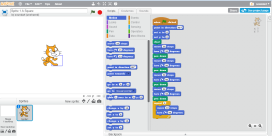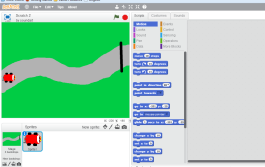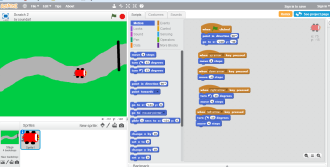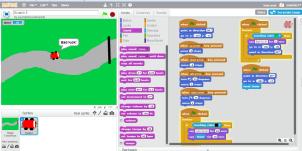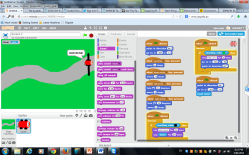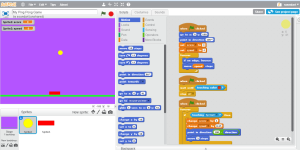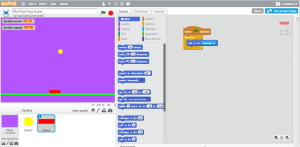Introduction to Scratch programming – Phase 1
What is Scratch?
Scratch is a free computer program offered by the Lifelong Kindergarten Group at MIT Media Lab that allows users to create their own interactive games, stories and animations that can be stored and shared online. Scratch is designed for children ages between 8 and 16. It can be used in the classroom for maths, language arts, computer science and social studies curriculum. Scratch has an online forum for educators that allow members to exchange resources and learning ideas.
You can read more about Scratch on their website; http://scratch.mit.edu/
Activity 1:
The first activity involved following a sequence of step by step instructions that made a computer animated cat (the Sprite), draw a square. This involved creating simple commands, command sequences and repeating command sequences. Simple commands were dragged onto the scripts area and values adjusted to demonstrate the way you could get a Sprite to move. Drawing regular polygons (in particular, the equilateral triangle) has still proven to be the most difficult and will require more time and trial and error before I perfect it.
Explanation activities can be found here, along with the Etch-a-Sketch activity which required us to change pen colour and size and draw as commands were issued from the keyboard.
Activity 2:
Built on the learnt knowledge of the first activity and described the process for developing a car racing game which included designing a background, a car (the Sprite) and then programming a sequence of steps to allow the car to cross the finish line.
Activity 3:
The third activity was similar to the second activity however we created a ping pong game where we designed the Sprites, background and programming instructions.
Links to the Australian Curriculum
The Australian Curriculum: Technologies (ACARA, 2014) includes Digital Technologies in the content structure.
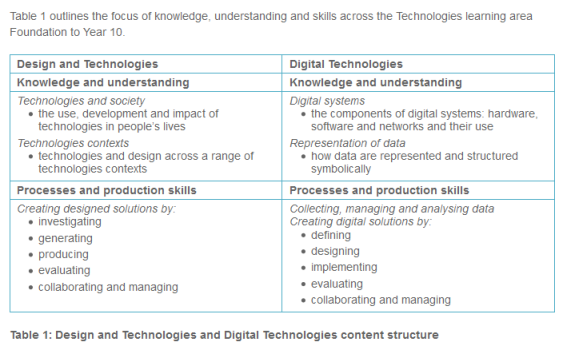
The table above shows how teachers can “select technologies-specific content from the Knowledge and understanding strand and students can apply skills from the Processes and production skills strand to that content” (ACARA, 2014).
The Technologies Curriculum can be retrieved from www.australiancurriculum.edu.au/technologies
The activities completed in phase 1 can be included in Foundation to Year 2 classrooms within the Australian Curriculum Technologies as follows:
Using digital systems
2.4 Identify, explore, and use digital systems (hardware and software components) for personal and classroom needs
* Exploring and identifying hardware and software components of digital systems when creating ideas and information, for example experimenting with different ways of providing instructions of games software using a mouse, touch pad, touch screen, keyboard or stylus, and using different software to manipulate text, numbers, sounds and images.
* Recognising that a digital system follows instructions or commands, for example instructing robotic toys to perform a function.
2.3 Follow, describe, represent and play with a sequence of steps and decisions needed to solve simple problems
*Experimenting and playing with very simple, step-by-step procedures to explore programmable devices.
What I have learnt
Throughout this activity I learnt how to modify simple algorithms using a sequence of steps to create different levels within a game as well as how to use a sensing mechanism to make my Sprite move along the maze. I consolidated previous learning’s by painting my new Sprites, added sound, selecting a relevant stage for the game for the chosen theme, setting the start point for each level and writing scripts for my main Sprite to appear as it touched different objects in the maze and earn points. This exploration has given me the confidence to be able to use Scratch in the classroom with primary students.
Potential application in the primary school classroom
Initially I thought the programming aspect of Scratch would be too difficult for early childhood classrooms however after reading the Draft Australian Curriculum: Technologies, I have learnt that simple programming is a requirement from the Foundation year as discussed above. In this regard Scratch activities such as activity 1 could be used to introduce students to geometric shapes.
Using existing Scratch games will allow the students to explore digital systems and experiment with their functions. I consider Scratch could be used in primary classrooms to introduce programming and digital systems in a way that will engage 21st Century learners.
Reference:
ACARA. (2014). The Australian Curriculum v6.0 Technologies: Technologies. Retrieved March 8, 2014, from http://www.australiancurriculum.edu.au/technologies/rationale-aims/technologies
scratch.mit.edu. (2014). Scratch – Imagine, Program, Share. Retrieved March 10, 2014, from http://www.scratch.mit.edu/
